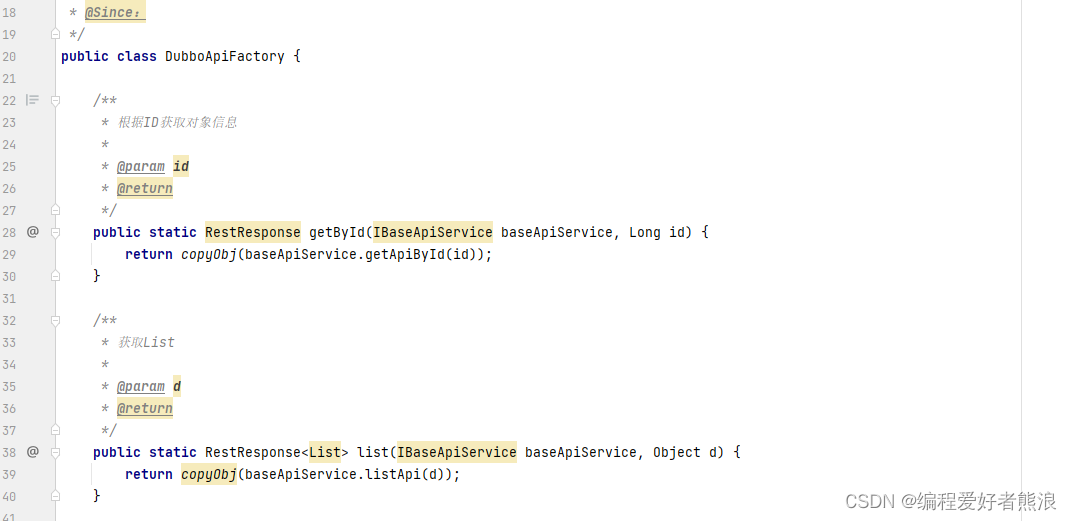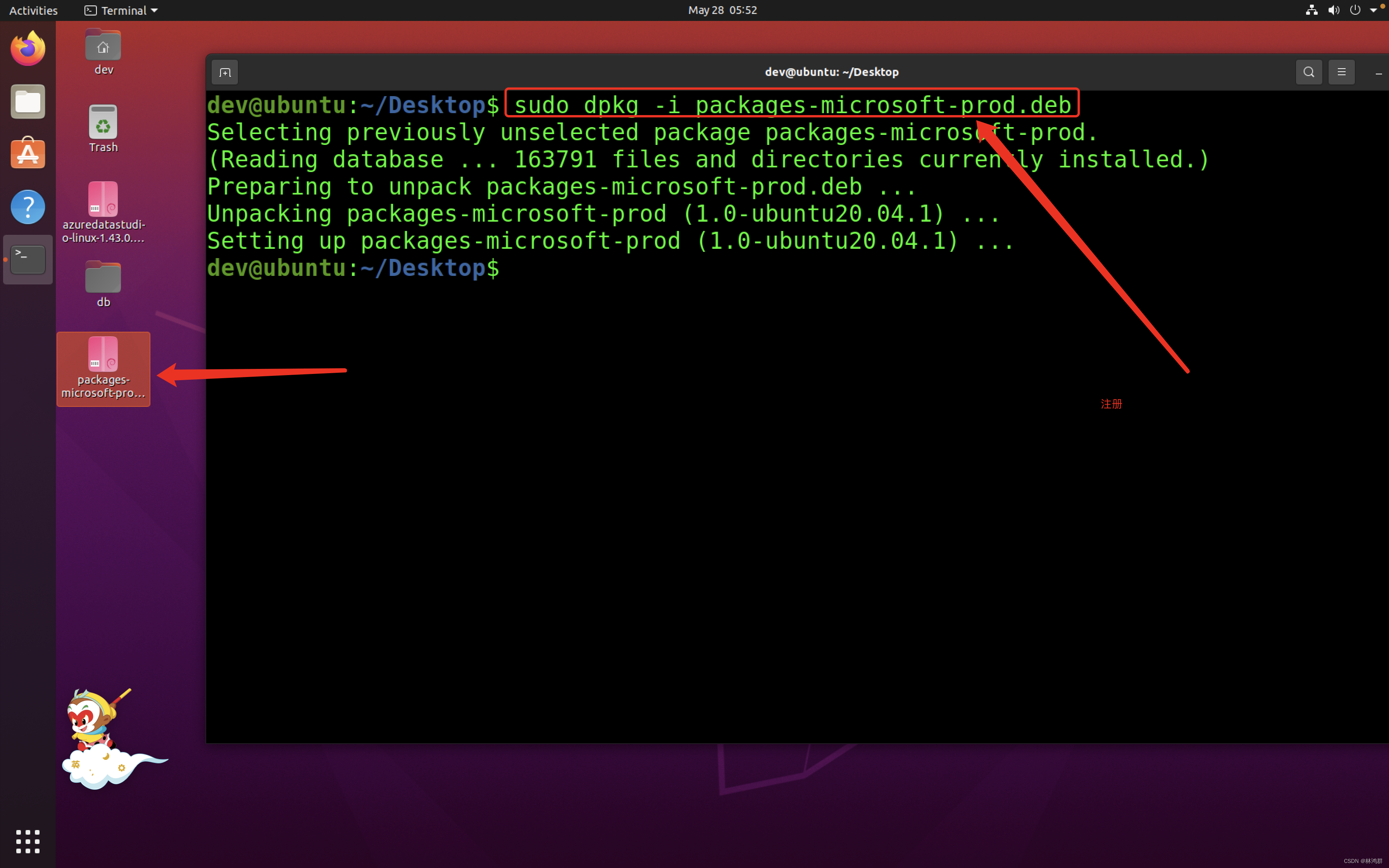1、服务器动态上下线监听案例
1、需求
某分布式系统中,主节点可以有多台,可以动态上下线,任意一台客户端都能实时感知到主节点服务器的上下线。
2、需求分析
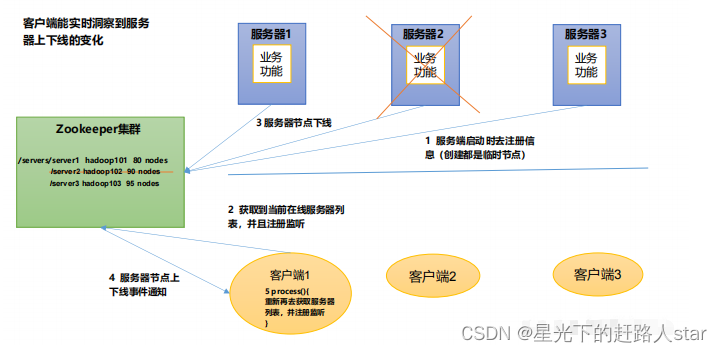
3、具体实现
(1)先在集群上创建/servers 节点

(2)在IDEA中创建包名:org.example.zkcase1
(3)服务端向Zookeeper注册代码
package org.example.zkcase1;import org.apache.zookeeper.*;import java.io.IOException;/*** @ClassName DistributeServer* @Description TODO* @Author Zouhuiming* @Date 2023/5/25 9:12* @Version 1.0*/
public class DistributeServer {private String connectString="hadoop102:2181,hadoop103:2181,hadoop104:2181";private int sessionTimeout=2000;ZooKeeper zk=null;private String parentNode="/servers";//创建到zk的客户端连接public void getConnect() throws IOException {zk=new ZooKeeper(connectString, sessionTimeout, new Watcher() {@Overridepublic void process(WatchedEvent watchedEvent) {}});}//注册服务器public void registServer(String hostname) throws InterruptedException, KeeperException {String create = zk.create(parentNode + "/servers", hostname.getBytes(), ZooDefs.Ids.OPEN_ACL_UNSAFE, CreateMode.EPHEMERAL_SEQUENTIAL);System.out.println(hostname+"is online"+create);}//业务功能public void business(String hostname) throws InterruptedException {System.out.println(hostname+" is working...");Thread.sleep(Long.MAX_VALUE);}public static void main(String[] args) throws IOException, InterruptedException, KeeperException {//1、获取zk连接DistributeServer server=new DistributeServer();server.getConnect();//2、利用zk连接注册服务器信息server.registServer(args[0]);//3、启动业务功能server.business(args[0]);}
}(4)客户端代码
package org.example.zkcase1;import org.apache.zookeeper.KeeperException;
import org.apache.zookeeper.WatchedEvent;
import org.apache.zookeeper.Watcher;
import org.apache.zookeeper.ZooKeeper;import java.io.IOException;
import java.util.ArrayList;
import java.util.List;/*** @ClassName DistributeClient* @Description TODO* @Author Zouhuiming* @Date 2023/5/25 9:23* @Version 1.0*/
public class DistributeClient {private String connectionString="hadoop102:2181,hadoop103:2181,hadoop104:2181";private int sessionTimeout=2000;private ZooKeeper zk;private String parentNode="/servers";//创建到zk的客户端连接public void getConnection() throws IOException {zk=new ZooKeeper(connectionString, sessionTimeout, new Watcher() {@Overridepublic void process(WatchedEvent watchedEvent) {//再次启动监听try {getServerList();} catch (InterruptedException e) {throw new RuntimeException(e);} catch (KeeperException e) {throw new RuntimeException(e);}}});}//获取服务器列表信息public void getServerList() throws InterruptedException, KeeperException {//1、获取服务器子节点信息,并且对父节点进行监听List<String> children = zk.getChildren(parentNode, true);//2、储存服务器信息列表ArrayList<String> servers=new ArrayList<>();//3、遍历所有节点,获取节点中的主机名称信息for (String child : children) {byte[] data = zk.getData(parentNode + "/" + child, false, null);servers.add(new String(data));}//4、打印服务器列表信息System.out.println(servers);}//业务功能public void business() throws InterruptedException {System.out.println("client is working...");Thread.sleep(Long.MAX_VALUE);}public static void main(String[] args) throws IOException, InterruptedException, KeeperException {//1、获取zk连接DistributeClient client=new DistributeClient();client.getConnection();//2、获取servers的子节点信息,从中获取服务器信息列表client.getServerList();//3、业务进程启动client.business();}
}4、测试
(1)在Linux命令行上操作增加减少服务器
(a)启动 DistributeClient 客户端
(b)在 hadoop102 上 zk 的客户端/servers 目录上创建临时带序号节点

(c)观察IDEA控制台变化

(d)执行删除操作

(e)观察IDEA控制台变化

(2)在IDEA上操作增加和减少服务器
(a)启动 DistributeClient 客户端(如果已经启动过,不需要重启)
(b)启动 DistributeServer 服务
①点击 Edit Configurations…

②在弹出的窗口中(Program arguments)输入想启动的主机,例如,hadoop102

③回到 DistributeServer 的 main 方 法 , 右 键 , 在 弹 出 的 窗 口 中 点 击 Run“DistributeServer.main()
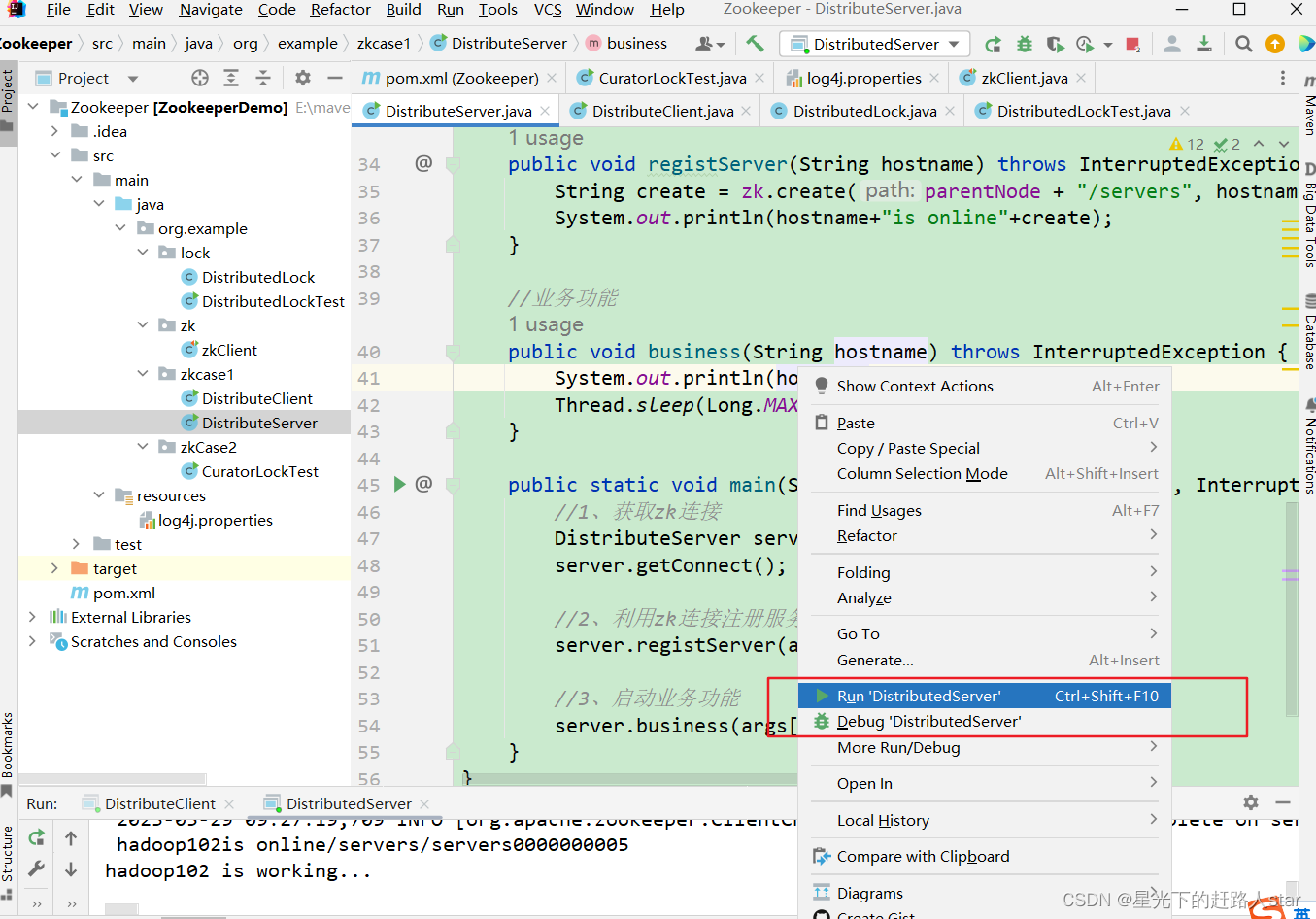
④观察 DistributeServer 控制台,提示 hadoop102 is working
⑤观察 DistributeClient 控制台,提示 hadoop102 已经上线
2、ZooKeeper 分布式锁案例
什么加做分布式锁呢?
比如说"进程 1"在使用该资源的时候,会先去获得锁,"进程 1"获得锁以后会对该资源保持独占,这样其他进程就无法访问该资源,"进程 1"用完该资源以后就将锁释放掉,让其他进程来获得锁,那么通过这个锁机制,我们就能保证了分布式系统中多个进程能够有序的访问该临界资源。那么我们把这个分布式环境下的这个锁叫作分布式锁。
2.1 原生 Zookeeper 实现分布式锁案例
1、分布式锁实现
package org.example.lock;import org.apache.zookeeper.*;
import org.apache.zookeeper.data.Stat;import java.io.IOException;
import java.util.Collections;
import java.util.List;
import java.util.concurrent.CountDownLatch;/*** @ClassName DistributedLock* @Description TODO* @Author Zouhuiming* @Date 2023/5/25 14:51* @Version 1.0*/
public class DistributedLock {//Zookeeper server列表private String connectString="hadoop102:2181,hadoop103:2181,hadoop104:2181";//超时时间private int sessionTimeout=2000;private ZooKeeper zk;private String rootNode="locks";private String subNode="seq-";//当前client等待的子节点private String waitPath;//Zookeeper连接private CountDownLatch connectLatch=new CountDownLatch(1);//Zookeeper节点等待private CountDownLatch waitLatch=new CountDownLatch(1);//当前client创建的子节点private String currentNode;//和zk服务建立连接,并创建根节点public DistributedLock() throws IOException, InterruptedException, KeeperException {zk=new ZooKeeper(connectString, sessionTimeout, new Watcher() {@Overridepublic void process(WatchedEvent watchedEvent) {//连接建立时,打开latch,唤醒wait在该latch上的线程if (watchedEvent.getState()==Event.KeeperState.SyncConnected){try {connectLatch.countDown();} catch (Exception e){e.printStackTrace();}}//发生了waitPath的删除事件if (watchedEvent.getType()==Event.EventType.NodeDeleted&&watchedEvent.getPath().equals(waitPath)){waitLatch.countDown();}}});//等待连接建立connectLatch.await();//获取根节点状态Stat stat = zk.exists("/" + rootNode, false);if (stat==null){System.out.println("根节点不存在");zk.create("/"+rootNode,new byte[0], ZooDefs.Ids.OPEN_ACL_UNSAFE,CreateMode.PERSISTENT);}}//加锁方法public void zkLock(){try {//在根节点下创建临时顺序节点,返回值为创建的节点路径currentNode=zk.create("/"+rootNode+"/"+subNode,null,ZooDefs.Ids.OPEN_ACL_UNSAFE,CreateMode.EPHEMERAL_SEQUENTIAL);//wait一会儿,让结果更加清晰一些Thread.sleep(10);//注意,没有必要监听"/locks"的子节点的变化情况List<String> childrenNodes = zk.getChildren("/" + rootNode, false);//列表中只有一个子节点,那肯定就是currentNode,说明client获得锁if (childrenNodes.size()==1){return;}else {//对根节点下的所有临时顺序节点从小到大排序Collections.sort(childrenNodes);//当前节点名称String thisNode = currentNode.substring(("/" + rootNode + "/").length());int index = childrenNodes.indexOf(thisNode);if (index==-1){System.out.println("数据异常");} else if (index==0) {//index==0,说明thisNode在列表中最小,当前client获得锁return;}else {//获得排名比current前一位的节点this.waitPath="/"+rootNode+"/"+childrenNodes.get(index-1);//在waitPath上注册监听器,当waitPath被删除时,Zookeeper会回调监听器的process方法zk.getData(waitPath,true,new Stat());//进入等待锁状态waitLatch.await();return;}}} catch (KeeperException e) {throw new RuntimeException(e);} catch (InterruptedException e) {throw new RuntimeException(e);}}//解锁方法public void zkUnlock(){try {zk.delete(this.currentNode,-1);} catch (InterruptedException e) {throw new RuntimeException(e);} catch (KeeperException e) {throw new RuntimeException(e);}}
}2、分布式锁测试
package org.example.lock;import org.apache.zookeeper.KeeperException;import java.io.IOException;/*** @ClassName DistributedLockTest* @Description TODO* @Author Zouhuiming* @Date 2023/5/25 15:27* @Version 1.0*/
public class DistributedLockTest {public static void main(String[] args) throws IOException, InterruptedException, KeeperException {//创建分布式锁final DistributedLock lock1=new DistributedLock();final DistributedLock lock2=new DistributedLock();new Thread(new Runnable() {@Overridepublic void run() {//获取锁对象try {lock1.zkLock();System.out.println("线程1获取锁");Thread.sleep(5*1000);lock1.zkUnlock();System.out.println("线程1释放锁");} catch (InterruptedException e) {e.printStackTrace();}}}).start();new Thread(new Runnable() {@Overridepublic void run() {//获取锁对象try {lock2.zkLock();System.out.println("线程2获取锁");Thread.sleep(5*1000);lock2.zkUnlock();System.out.println("线程2释放锁");} catch (InterruptedException e) {e.printStackTrace();}}}).start();}
}(2)观察控制台变化
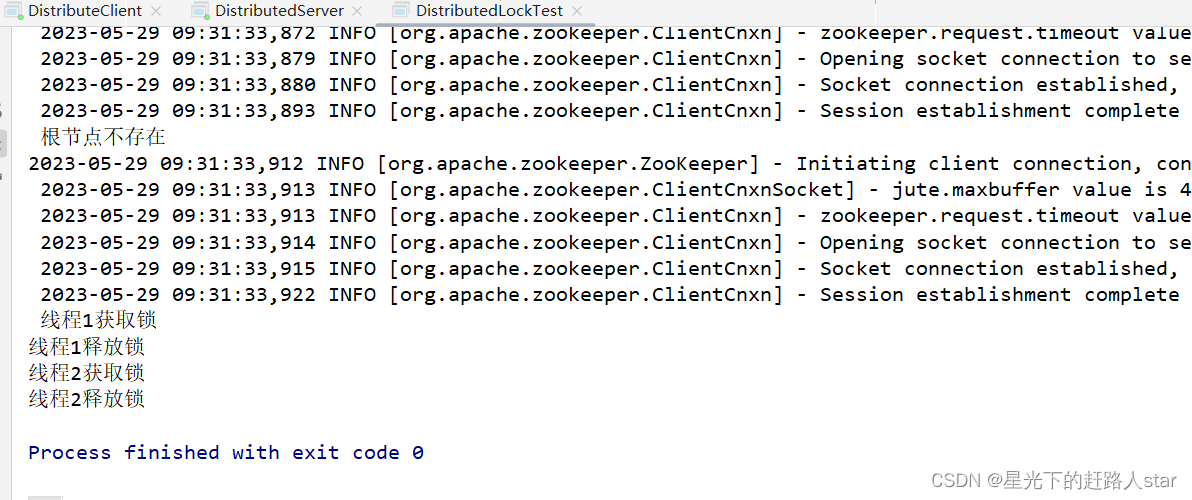
2.2 Curator框架实现分布式锁案例
1、原生的 Java API 开发存在的问题
(1)会话连接是异步的,需要自己去处理。比如使用 CountDownLatch
(2)Watch 需要重复注册,不然就不能生效
(3)开发的复杂性还是比较高的
(4)不支持多节点删除和创建。需要自己去递归
2、Curator 是一个专门解决分布式锁的框架,解决了原生 JavaAPI 开发分布式遇到的问题。
3、Curator 案例实操
(1)添加依赖
<dependency><groupId>org.apache.curator</groupId><artifactId>curator-framework</artifactId><version>4.3.0</version>
</dependency>
<dependency><groupId>org.apache.curator</groupId><artifactId>curator-recipes</artifactId><version>4.3.0</version>
</dependency>
<dependency><groupId>org.apache.curator</groupId><artifactId>curator-client</artifactId><version>4.3.0</version>
</dependency>
(2)代码实现
package org.example.zkCase2;import org.apache.curator.framework.CuratorFramework;
import org.apache.curator.framework.CuratorFrameworkFactory;
import org.apache.curator.framework.recipes.locks.InterProcessLock;
import org.apache.curator.framework.recipes.locks.InterProcessMutex;
import org.apache.curator.retry.ExponentialBackoffRetry;/*** @ClassName CuratorLockTest* @Description TODO* @Author Zouhuiming* @Date 2023/5/25 15:52* @Version 1.0*/
public class CuratorLockTest {private String rootNode="/locks";//zookeeper server列表private String connectString="hadoop102:2181,hadoop103:2181,hadoop104:2181";//connection超时时间private int connectionTimeOut=2000;//session超时时间private int sessionTimeOut=2000;public static void main(String[] args) {new CuratorLockTest().test();}//测试private void test(){//创建分布式锁1final InterProcessLock lock1=new InterProcessMutex(getCuratorFramework(),rootNode);//创建分布式锁2final InterProcessLock lock2=new InterProcessMutex(getCuratorFramework(),rootNode);new Thread(new Runnable() {@Overridepublic void run() {//获取锁对象try {lock1.acquire();System.out.println("线程1获取锁");//测试锁重入lock1.acquire();System.out.println("线程1再次获取锁");lock1.release();System.out.println("线程1释放锁");lock1.release();System.out.println("线程1再次释放锁");} catch (Exception e) {throw new RuntimeException(e);}}}).start();new Thread(new Runnable() {@Overridepublic void run() {//获取锁对象try {lock2.acquire();System.out.println("线程2获取锁");//测试锁重入lock2.acquire();System.out.println("线程2再次获取锁");lock2.release();System.out.println("线程2释放锁");lock2.release();System.out.println("线程2再次释放锁");} catch (Exception e) {throw new RuntimeException(e);}}}).start();}//分布式锁初始化private CuratorFramework getCuratorFramework() {//重试策略,初始时间3秒,重试3次ExponentialBackoffRetry policy = new ExponentialBackoffRetry(3000, 3);//通过工厂创建CuratorCuratorFramework client= CuratorFrameworkFactory.builder().connectString(connectString).connectionTimeoutMs(connectionTimeOut).sessionTimeoutMs(sessionTimeOut).retryPolicy(policy).build();//开启连接client.start();System.out.println("zookeeper 初始化完成...");return client;}
}(3)观察控制台变化
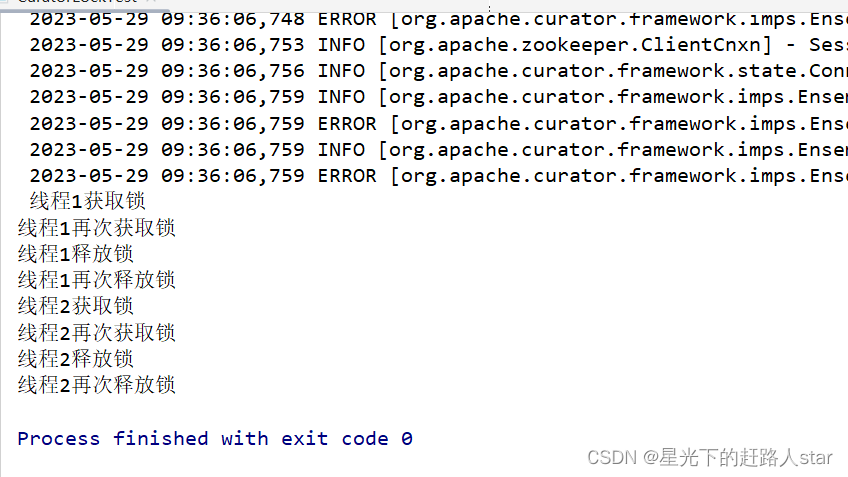
3、企业面试真题
3.1 选举机制
半数机制·,超过半数的投票通过,即通过。
1、第一次启动选举机制:
投票过半数时,服务器id大的胜出
2、第二次启动选举规则:
(1)EPOCH大的直接胜出
(2)EPOCH相同,事务id大的胜出
(3)事务id相同,服务器id大的胜出
3.2 生产集群安装多少zk合适
安装奇数台。
生产经验:
- 10台服务器:3台zk
- 20台服务器:5台zk
- 100台服务器:11台zk
- 200台服务器:11台zk
服务器台数多:
(1)好处:提高可靠性
(2)坏处:提高通信延时
3.3 常用命令
ls、get、create、delete

